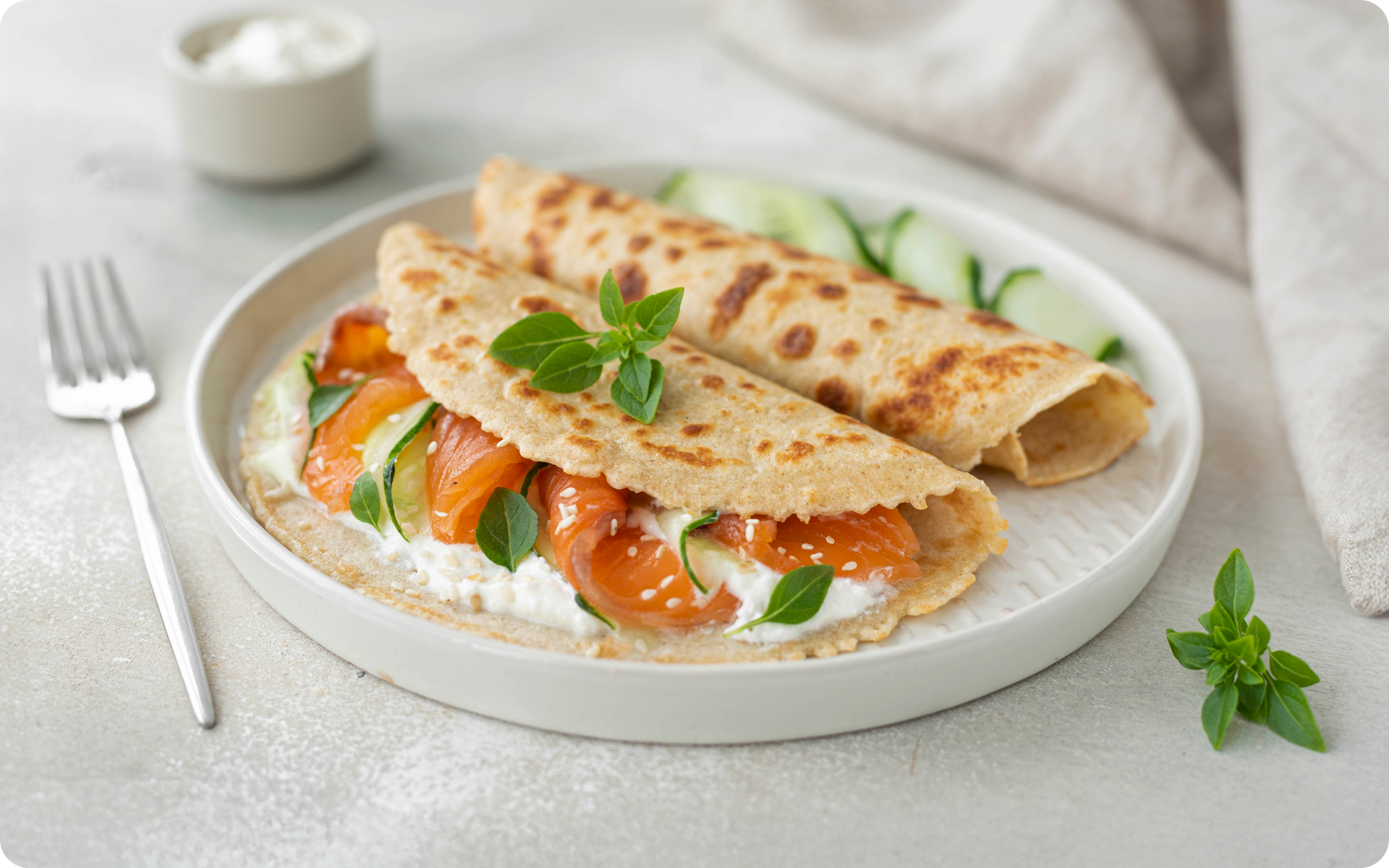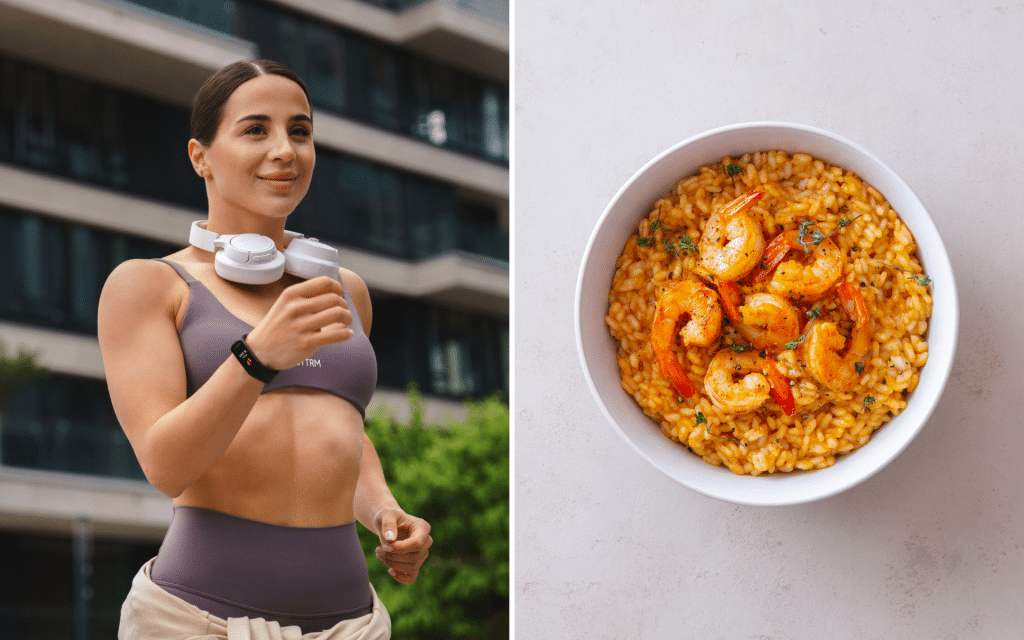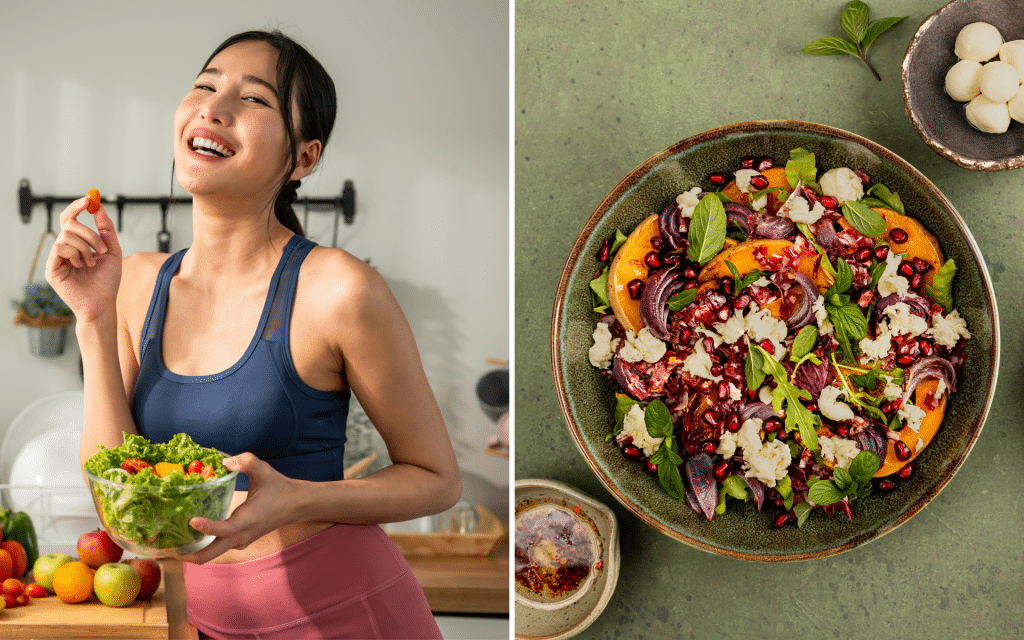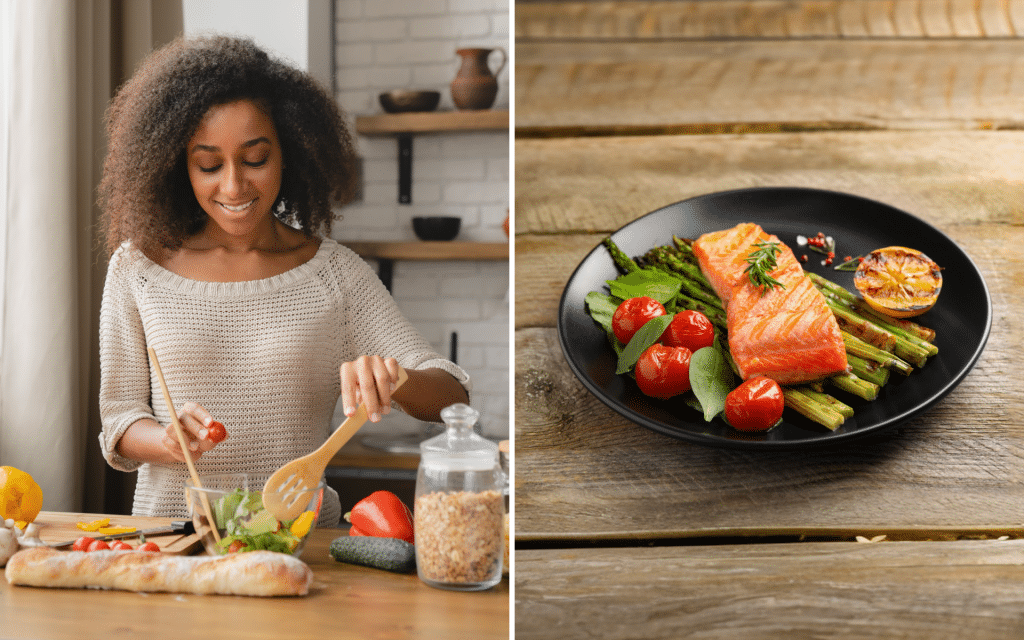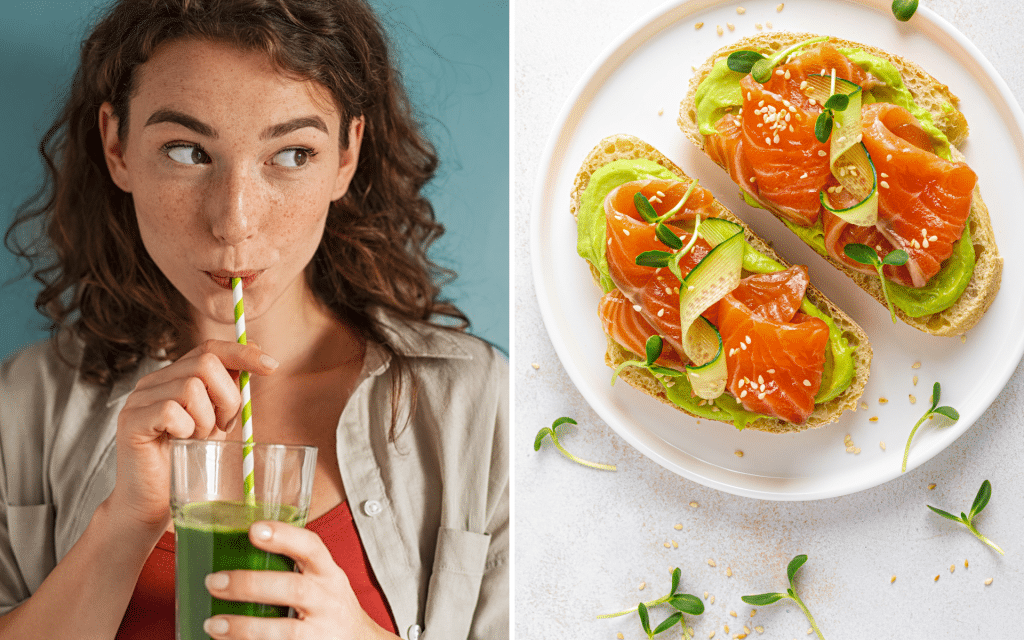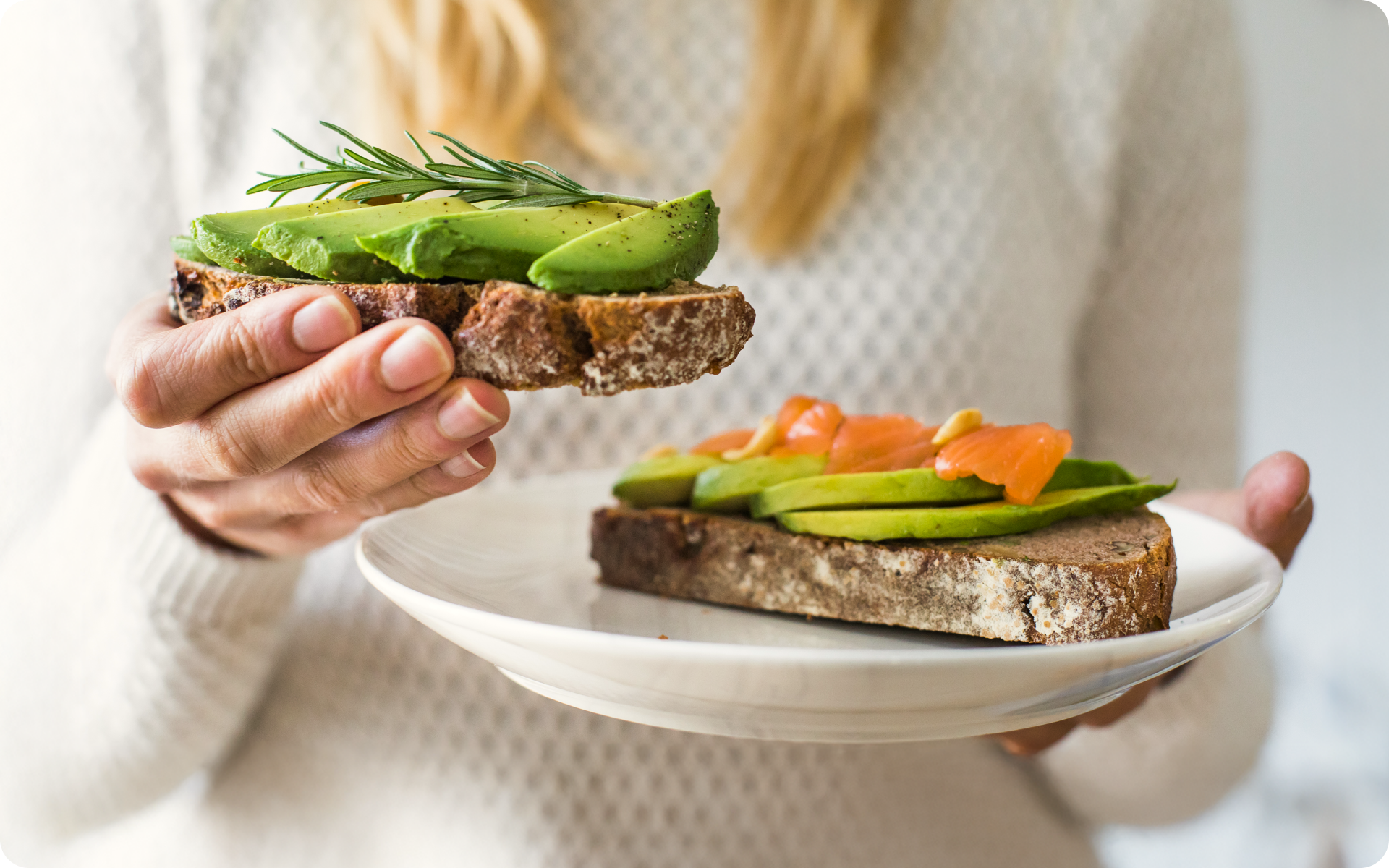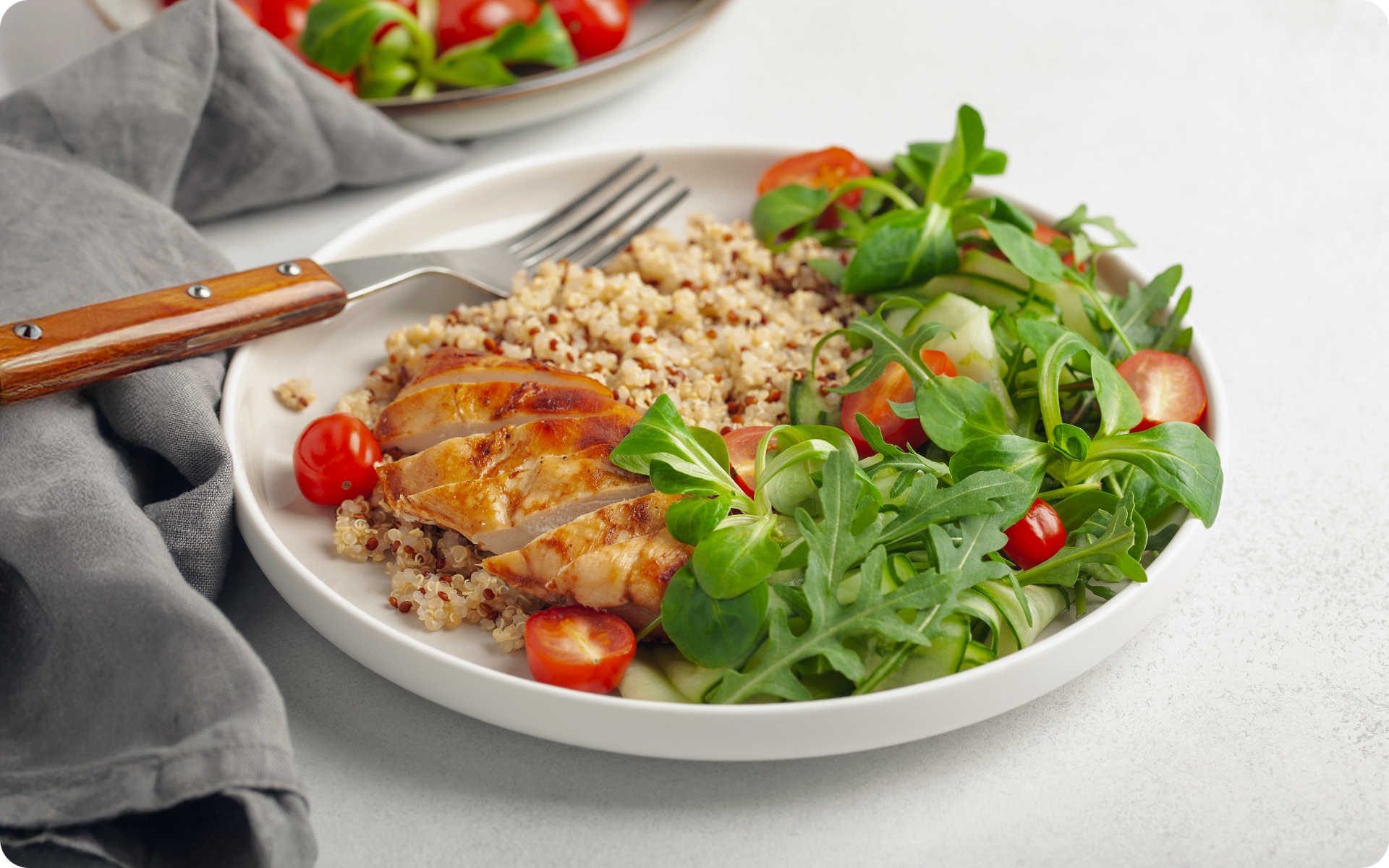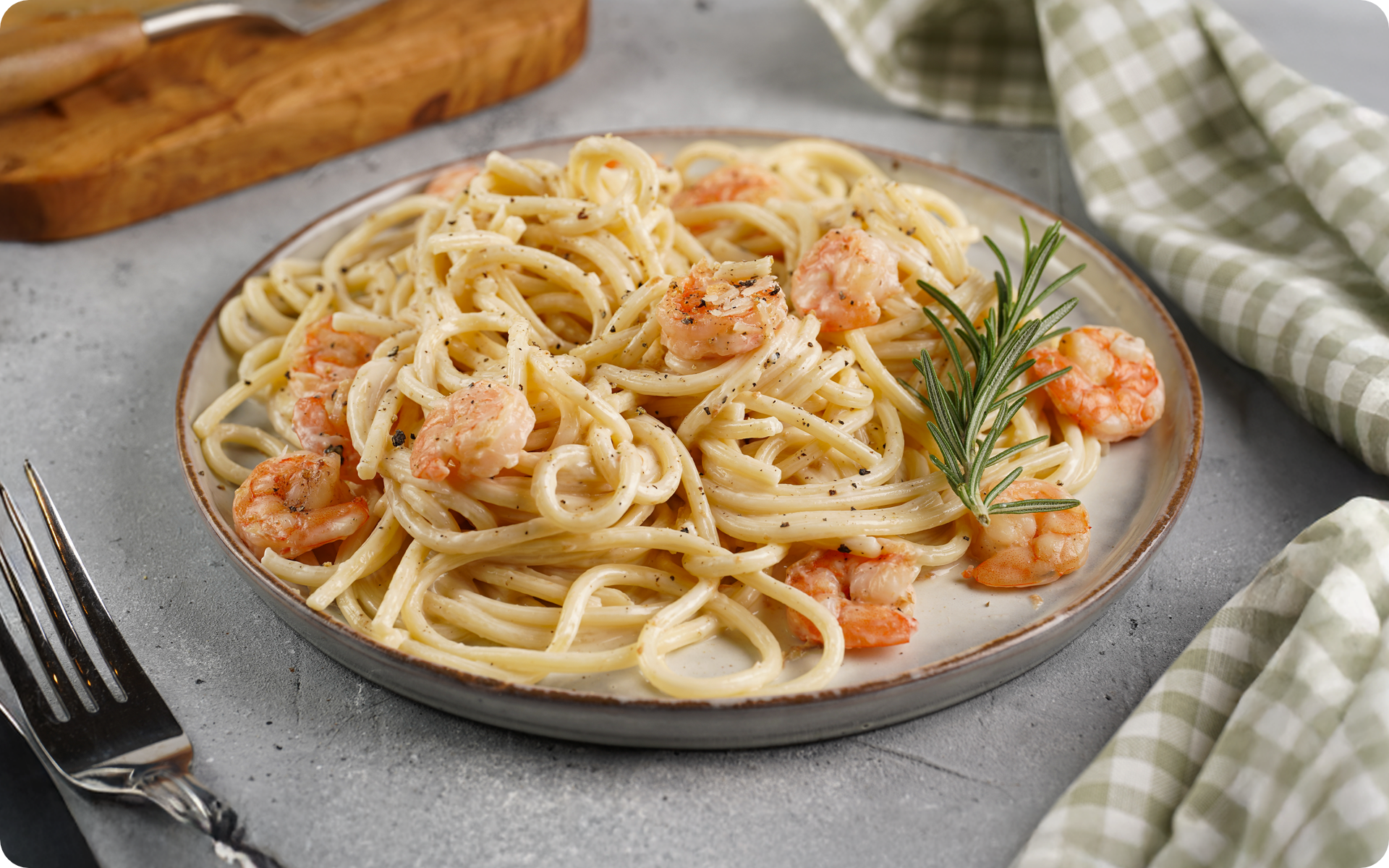What you eat for breakfast matters as much as whether you eat it. Starting your day with a high-protein breakfast can set you up for success.
Research has suggested that protein in the morning helps reduce food cravings, which keeps you fuller for longer (1). It can also support muscle maintenance and even boost your metabolism slightly, thanks to what’s called the “thermic effect” of protein (aka the calories your body burns just digesting it) (2, 3).
Here’s where it gets tricky. When we think of high-protein breakfasts, eggs often dominate the conversation. They’re versatile, affordable, and a go-to choice. However, not everyone eats or even enjoys eggs.
Whether due to dietary restrictions, allergies, or simply being tired of the same scramble every day, some of us are on the lookout for alternatives.
In this article, I’ll share 10 creative, egg-free ideas that will keep you full, energized, and ready to take on the day, all while staying true to your nutritional goals.
What Protein Is Good for Breakfast Besides Eggs?
If eggs aren’t on your menu, don’t worry as there are plenty of other protein-packed options to power your mornings. From creamy dairy products to plant-based staples and convenient protein powders, breakfast protein is more versatile than you might think. Here are some excellent choices you can consider:
- Greek Yogurt
Greek yogurt is a breakfast superstar, offering approximately 10-18 grams of protein per 6-ounce serving (4). It’s lower in sugar than standard yogurt and packed with probiotics, which are great for gut health (5).
Its creamy texture also works beautifully in parfaits, smoothies, or as a base for fruit and nut toppings.
Pro tip: Choose plain, unsweetened Greek yogurt to avoid added sugars and sweeten it yourself with a drizzle of honey or fresh fruit.
- Cottage Cheese
Cottage cheese may be underrated, but it’s a protein heavyweight, delivering around 13 grams of protein per half-cup (6).
It’s rich in casein (7), a slow-digesting protein that can help keep you satisfied for hours. Spread it on whole-grain toast, mix it into a smoothie, or pair it with fresh fruit for a balanced, protein-packed start to your day.
- Tofu
Tofu isn’t just for lunch or dinner, it’s a fantastic breakfast option too. A 3-ounce serving contains approximately 9 grams of high-quality (8), plant-based protein.
Tofu is a complete protein (9), which means it contains all nine essential amino acids your body needs. Scramble it with vegetables, toss it into a breakfast bowl, or blend silken tofu into a smoothie for creamy protein power.
- Legumes and Beans
Yes, beans can make a breakfast appearance. Black beans, chickpeas, or lentils are excellent sources of protein (10). Consider incorporating them into savory breakfast bowls or wraps, topping avocado toast with spiced chickpeas, or blending them into a breakfast hummus spread.
Reasons why BetterMe is a safe bet: a wide range of calorie-blasting workouts, finger-licking recipes, 24/7 support, challenges that’ll keep you on your best game, and that just scratches the surface! Start using our app and watch the magic happen.
- Nuts and Nut Butters
Almonds, peanuts, and walnuts bring both healthy fats and protein to the table. For example, just two tablespoons of peanut butter pack about 7 grams of protein (11). Spread almond butter on toast, sprinkle chopped nuts on oatmeal, or blend them into smoothies for a satisfying crunch.
- Seeds
Seeds, such as chia, flax, or hemp, may be tiny, but they’re a sneaky source of plant-based protein. For example, four tablespoons of hemp seeds provide approximately 16 grams of protein (12). Toss them into oatmeal, yogurt, or smoothies for an extra protein boost, along with fiber and omega-3 fatty acids.
- Protein Powders
For those on the go, protein powders can be a game-changer. Options such as whey, pea, or brown rice protein are versatile and easy to add to smoothies, oatmeal, or even pancake batter.
Look for options with minimal added sugar. Bonus tip: Mix protein powder into unsweetened almond milk for a rich, creamy shake.
Read more: High-Protein Non-Dairy Breakfast Options to Try Today
What Can I Cook for a High-Protein Breakfast Without Eggs?
1. Greek Yogurt Breakfast Bowls
Greek yogurt is rich in protein (about 10-15 grams per serving) and probiotics, which may benefit gut health (4, 5). Start with a base of creamy, unsweetened Greek yogurt, then top it with your favorite fruits, nuts, seeds, or even granola.
These toppings add flavor and bring in fiber, healthy fats, and a slight crunch. The beauty of yogurt bowls is how customizable they are – you can make them simple or fancy, depending on your mood.
Want to try one out? This Greek Yogurt Breakfast Bowl recipe suggests toppings such as fresh blueberries, honey, and granola for a well-rounded breakfast.
2. Tofu Scramble
Tofu scrambles are a plant-based take on scrambled eggs, offering a hearty dose of protein (approximately 9 grams per 3 ounces) (8). Tofu is a complete protein, which means it contains all nine essential amino acids your body needs (9).
You can pair it with any combination of vegetables for added fiber and nutrients. Spices such as turmeric, paprika, or nutritional yeast can enhance the flavor while mimicking the color of scrambled eggs. It’s a warm, savory dish that works wonderfully solo or tucked into whole-grain wraps.
Check out this Tofu and Vegetable Scramble recipe that’s not only quick but completely customizable.
3. Smoothies and Smoothie Bowls
Smoothies can be a lifesaver for busy mornings. They’re quick to make, portable, and packed with nutrients. For a high-protein version, blend Greek yogurt, silken tofu, or plant-based protein powders with fruits such as bananas, berries, or mango.
Do you want to boost the protein further? Toss in some chia or hemp seeds. Turning your smoothie into a bowl allows you to add toppings such as nuts and granola, which makes it a more filling and textured breakfast.
This Chocolate-Peanut Butter Protein Shake recipe tastes like a treat but delivers a significant protein punch to fuel your morning.
4. Overnight Quinoa Pudding
Quinoa isn’t just for lunch or dinner. This versatile grain offers approximately 6 grams of protein per quarter cup (uncooked) (13). Transform it into a sweet breakfast pudding by mixing cooked quinoa with your milk of choice, chia seeds, and a touch of maple syrup.
Leave it overnight in the fridge and top with fresh berries and nuts in the morning. It’s creamy, slightly nutty, and perfect for meal prep.
Try this Overnight Quinoa Pudding recipe for a simple and satisfying breakfast option.
5. Avocado Toast with Protein Toppings
Avocado toast is a breakfast favorite, but the real power lies in the toppings. Layer mashed avocado on whole-grain bread, then add protein-rich ingredients such as smoked salmon, cottage cheese, or hemp seeds.
The healthy fats from avocado combined with the fiber in whole-grain bread and protein toppings make this dish a triple threat for keeping you energized and full.
This High-Protein Vegan Avocado Toast features seasoned smashed chickpeas for a protein boost, paired with creamy avocado on crispy sourdough.
6. Protein-Packed Parfaits
Layer Greek yogurt with a variety of fresh fruits and crunchy granola for a breakfast parfait that feels like a treat but is seriously nourishing. Parfaits are beautiful and also flexible – you can make them in advance and grab them on your busiest mornings. If you prefer a non-dairy version, simply swap the Greek yogurt for a plant-based alternative.
Do you need inspiration? This Strawberry and Yogurt Parfait recipe shows you how to combine the sweet and tangy flavors into a simple, delicious dish.
7. Chickpea Pancakes (Socca)
Chickpea flour is a fantastic high-protein, gluten-free option for breakfast pancakes. Rich in protein (approximately 20 grams per cup of flour) and fiber (14), these savory pancakes can be customized with your favorite add-ins, such as herbs, spinach, or a touch of cheese. Serve them hot with hummus, avocado, or a dollop of Greek yogurt for a balanced meal.
Give this Chickpea Pancakes Recipe a try – it’s quick, tasty, and packed with plant-based protein.
Oats are already nutritious, but you can take them to the next level by adding protein-rich ingredients. Stir in a scoop of protein powder, a tablespoon of peanut butter, or some chia seeds while cooking.
Top with nuts, berries, and a drizzle of honey for added flavor and texture. This combination provides a hearty dose of protein, complex carbs, and healthy fats to keep you energized.
This Chocolate Peanut Butter Protein Oatmeal is a must-try for a creamy and satisfying morning meal.
9. Smoked Salmon and Hummus Breakfast Wrap
Whole-grain wraps make an excellent base for a high-protein breakfast. Layer a wrap with smoked salmon (which is rich in omega-3 fats and about 18 grams of protein per 3 ounces) (15), a generous smear of hummus, and some fresh spinach or arugula. Roll it up for a nutrient-dense breakfast that’s portable and easy to prepare.
This Smoked Salmon Breakfast Wrap recipe combines protein, healthy fats, and greens for a satisfying meal.
10. Lentil Breakfast Bowls
Cooked lentils are an unexpected but fantastic choice for a savory breakfast bowl. Packed with approximately 18 grams of protein per cup (16), lentils pair well with roasted vegetables, tahini drizzle, and whole-grain toast on the side. They’re hearty, filling, and an excellent source of iron and fiber, which makes them perfect for a long-lasting energy boost.
Explore this Savory Lentil Bowl recipe for creative ways to enjoy lentils in the morning.
Which Food Has Equal Protein to Eggs?
An egg typically contains approximately 6-7 grams of protein (17), depending on its size. Foods with a similar protein content include:
- Greek Yogurt (Plain, Non-Fat): About 10 grams of protein per 100 grams (4).
- Cottage Cheese: Around 13 grams of protein per 1/2 cup (6).
- Tofu (Firm): Approximately 9 grams of protein per 3 ounces (8).
- Almonds: About 6 grams of protein in a 1-ounce serving (roughly 23 almonds) (18).
- Lentils: Around 18 grams of protein per cup cooked (16).
- Quinoa: About 6 grams of protein per 1/4 cup uncooked (13)
- Chicken Breast: A 100g portion contains roughly 31 grams of protein (19)
How to Get 30g of Protein for Breakfast Without Eggs
Here are some ideas for a breakfast that provides around 30g of protein, without using any eggs:
Greek Yogurt Bowl
- 1 container (170g) of plain Greek yogurt (17g protein)
- 2 tablespoons of peanut butter (7g protein)
- A handful of chia seeds (2g protein)
Protein Smoothie
- 1 scoop of protein powder (20-25g protein, depending on the brand)
- 1 cup of unsweetened almond milk (1g protein)
- 1 tablespoon of almond butter (3g protein)
- Add some frozen berries and spinach for flavor and nutrients.
Cottage Cheese and Toast
- 1 cup (170g) of low-fat cottage cheese (26g protein)
- 1 slice of whole-grain toast (3g protein)
Tofu Scramble
- 1/2 block (150g) of firm tofu (15g protein)
- Add nutritional yeast (2g protein per tablespoon)
- Pair with a slice of whole-grain toast (3g protein) and some sautéed veggies.
Overnight Oats with Protein Powder
- 1/2 cup of oats (5g protein)
- 1 scoop of protein powder (20-25g protein)
- Mix with almond milk and top with nuts or seeds for extra protein.
Read more: High Protein Breakfast Meal Prep: 7 Simple Make-Ahead Recipes
How Can You Cook Eggs for Breakfast if You Don’t Like Them?
Eggs are a nutritional powerhouse, packed with high-quality protein, vitamins, and minerals. However, if you’re not a fan of their flavor or texture, incorporating them into your breakfast can feel like a challenge. The good news? With a little creativity, you can reap the benefits of eggs without actually tasting or realizing you’re eating them. Here are some practical ways you can make eggs more palatable.
- Blend Them into Smoothies
It may sound unconventional, but eggs – particularly pasteurized liquid eggs or raw egg whites – can be blended into smoothies. When they’re mixed with fruits, yogurt, and a hint of sweetener, the flavor is completely masked. In addition, the eggs add a protein boost, which makes the smoothie more filling and nutritious. For safety, always use pasteurized eggs to avoid any raw egg risks.
- Bake Them into Muffins or Pancakes
Eggs are often a crucial ingredient in baked goods, and incorporating them this way can be a great option if you’re texture-sensitive. Try savory breakfast muffins with spinach, cheese, and herbs, or protein-packed pancakes made with eggs and a touch of banana or oats. These dishes deliver the benefits of eggs in a subtle way that’s easier to enjoy.
- Use Eggs as a Hidden Ingredient in Savory Recipes
Eggs can be folded into cooked dishes where they’re almost undetectable. A great example is stir-fried rice or noodles – use a small amount of beaten egg and cook it into the dish alongside your favorite vegetables, seasonings, and sauces. The rich flavors of soy sauce, garlic, and spices can completely disguise the egg.
BetterMe is your fast-track ticket to long-lasting weight loss! Tailor your fitness journey and maximize your results with just a couple of swipes!
- Turn Them Into Savory Pancakes or Fritters
Mix eggs into a batter with finely chopped vegetables, a sprinkle of spices, and a bit of flour or breadcrumbs to create fritters or vegetable-packed pancakes. Cook until golden brown for a crispy exterior and tender interior. The vegetables and seasonings will take the spotlight, making the egg just a supporting ingredient for texture and structure.
- Mask Them with Strong Flavors
Pairing eggs with bold ingredients can help minimize their taste. For example, scramble eggs with flavorful cheese, such as sharp cheddar or feta, and mix in sun-dried tomatoes, roasted red peppers, or pesto. These dynamic flavors can overpower the egg’s natural profile, creating a dish that’s rich and tasty.
- Try Creamier Cooking Methods
Experimenting with alternative cooking techniques can also make eggs more palatable. For example:
- Low and Slow Scramble: Cook eggs over low heat, constantly stirring, to create a creamy, custard-like texture.
- Egg Drop Soup: Whisked eggs, swirled into hot broth, take on a soft, delicate texture that’s completely different from traditional scrambled eggs or fried eggs. The broth also adds extra flavor.
- Incorporate Spices and Herbs
Don’t overlook the power of seasoning. Strong spices such as cumin, turmeric, smoked paprika, or curry powder can completely elevate an egg dish. Fresh herbs such as parsley, chives, or cilantro add a burst of freshness that can balance the richness of the eggs.
Two eggs provide approximately 12 grams of protein, which is a good amount for breakfast, but it probably won’t meet your total daily protein needs, depending on your activity level and dietary requirements. For reference, the average adult needs approximately 46-56 grams of protein daily at a minimum (20). Bananas can replace eggs in certain recipes, such as baked goods, as a binding ingredient. However, they’re not a comparable protein source as one medium banana contains only about 1 gram of protein (21). For baking, you can replace 3 eggs with about ¾ cup of yogurt as a binding and moisture substitute. But nutritionally, ¾ cup of Greek yogurt provides around 13-15 grams of protein, which is slightly more than the protein from 3 eggs (18 grams). Yes, tofu can replace eggs in cooked dishes such as scrambles. Half a cup of firm tofu provides approximately 10 grams of protein and works well as a plant-based, high-protein alternative to eggs.Frequently Asked Questions
Is 2 eggs a day enough protein?
Can bananas replace eggs?
How much yogurt is needed to replace 3 eggs?
Can tofu replace eggs?
The Bottom Line
Starting your day with a high-protein meal doesn’t require eggs. From Greek yogurt and tofu to seeds, nuts, and lentils, there are plenty of options to fuel your morning. These foods provide the protein your body needs and deliver essential nutrients such as fiber, vitamins, and healthy fats.
DISCLAIMER:
This article is intended for general informational purposes only and does not serve to address individual circumstances. It is not a substitute for professional advice or help and should not be relied on for making any kind of decision-making. Any action taken as a direct or indirect result of the information in this article is entirely at your own risk and is your sole responsibility.
BetterMe, its content staff, and its medical advisors accept no responsibility for inaccuracies, errors, misstatements, inconsistencies, or omissions and specifically disclaim any liability, loss or risk, personal, professional or otherwise, which may be incurred as a consequence, directly or indirectly, of the use and/or application of any content.
You should always seek the advice of your physician or other qualified health provider with any questions you may have regarding a medical condition or your specific situation. Never disregard professional medical advice or delay seeking it because of BetterMe content. If you suspect or think you may have a medical emergency, call your doctor.
SOURCES:
- A randomized crossover, pilot study examining the effects of a normal protein vs. high protein breakfast on food cravings and reward signals in overweight/obese “breakfast skipping”, late-adolescent girls (2014, springer.com)
- Effect of breakfast protein intake on muscle mass and strength in adults: a scoping review (2025, academic.oup.com)
- Effects of protein quantity and type on diet induced thermogenesis in overweight adults: A randomized controlled trial (2019, sciencedirect.com)
- Yogurt, Greek, plain, nonfat (2019, fdc.nal.usda.gov)
- Yoghurt consumption is associated with changes in the composition of the human gut microbiome and metabolome (2022, bmcmicrobiol.biomedcentral.com)
- COTTAGE CHEESE (2019, fdc.nal.usda.gov)
- Isolation and characterisation of milk-derived amyloid-like protein aggregates (MAPA) from cottage cheese (2022, nih.gov)
- Tofu, raw, regular, prepared with calcium sulfate (2019, fdc.nal.usda.gov)
- Soy: a complete source of protein (2009, nih.gov)
- Health Benefits of Plant-Based Nutrition: Focus on Beans in Cardiometabolic Diseases (2021, mdpi.com)
- Peanut butter, smooth style, without salt (2019, fdc.nal.usda.gov)
- ORGANIC HEMP SEEDS, ORGANIC (2016, fdc.nal.usda.gov/)
- ORGANIC QUINOA (2018, fdc.nal.usda.gov)
- Chickpea flour (besan) – 1 cup (2019, fdc.nal.usda.gov)
- Fish, salmon, Atlantic, farmed, raw (2019, fdc.nal.usda.gov)
- Lentils, mature seeds, cooked, boiled, without salt (2019, fdc.nal.usda.gov)
- National Egg Day: An Egg-cellent Source of Nutrition (2022, nifa.usda.gov)
- Nuts, almonds (2019, fdc.nal.usda.gov)
- Chicken, broilers or fryers, breast, meat only, cooked, roasted (2019, fdc.nal.usda.gov)
- Revised Reference Values for the Intake of Protein (2019, karger.com)
- Bananas, raw (2019, fdc.nal.usda.gov)
